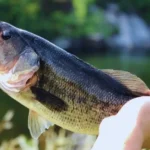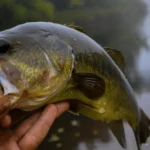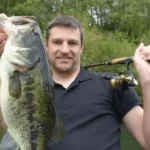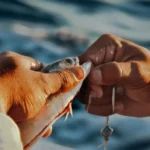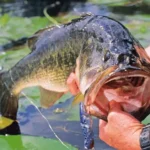Is it time to get the lowdown on How to Use a Fish Stringer? Learning how to use a fish stringer may make a massive difference in your fishing experience, whether you’re a seasoned pro or just getting started. So that you may feel prepared to safely store and transport your catch on your next fishing trip, we’ll cover the basics of how to use a fish stringer five times over in this short tutorial.
![[Fish on Stringer] How to Use a Fish Stringer?](https://fishingsaga.com/wp-content/uploads/2023/09/Fish-on-Stringer-1024x536.webp)
What is a Fish Stringer?
A fish stringer is a tool anglers use to keep their catch fresh and alive in the water while they continue to fish. It comprises a rope or cable with a series of clips or hooks attached, connecting the fish to the stringer. The stringer is then anchored to the shore or a boat to keep the fish submerged in the water. Fish stringers can be made of metal, plastic, or other materials and are available in different lengths and designs. Fishermen use them worldwide to preserve their catch until they are ready to be cleaned and cooked. Using a fish stringer is a simple and effective way to manage your catch while Fishing.
Types of Fish Stringers
Fish stringers come in various types, each designed to cater to different fishing needs. The most common types of fish stringers include:
- Rope Fish Stringers are the most basic and affordable fish stringers available. They are made of a length of rope with clips or hooks attached at regular intervals. They are best suited for smaller fish, as larger fish can put too much strain on the string and break free.
- Metal Fish Stringers are more durable and reliable than rope fish stringers. They are made of metal cables with clips or hooks attached to them. You can use them to hold larger fish, but they can also be heavier and more challenging than rope fish stringers.
- Plastic Fish Stringers – These are lightweight and rust-resistant, making them ideal for use in saltwater. They are typically made of PVC material and feature clips or hooks spaced at regular intervals along the stringer. They are best suited for smaller fish but can also be used for larger fish.
- Electronic Fish Stringers – These advanced fish stringers use electronic sensors to monitor the fish’s health and well-being. They are typically used for catch-and-release Fishing. They allow anglers to track the fish’s recovery and release it back into the water when it is healthy enough to survive.
Overall, the type of fish stringer best for you will depend on the fish you are targeting, your preferences, and your fishing style. It’s essential to choose a stringer that is durable, reliable, and easy to use so that you can focus on enjoying your fishing experience.
How to Prepare the Fish Stringer
Before using your fish stringer, it’s essential to prepare it properly to ensure it is clean and safe. Steps to prepare your fish stringer:
- Inspect the stringer for any signs of damage, such as frayed rope or broken clips. If you find any damage, replace the stringer before using it.
- Clean the stringer thoroughly using soap and water. It’ll also assist in removing any dirt, debris, or bacteria from the stringer.
- If using a metal stringer, apply a coat of rust-resistant spray to protect it from corrosion.
- Rinse the stringer with fresh water to remove any soap residue.
- Attach a float to the end of the stringer to help keep it visible and prevent it from getting tangled in weeds or other debris.
- If using a rope stringer, soak it in water for a few minutes before use. It will decrease the possibility of the rope stretching or breaking.
- If using a plastic or electronic stringer, ensure the clips or hooks are securely attached to the cable or line.
Once you have prepared your fish stringer, it’s essential to use it correctly to ensure that your catch remains fresh and alive in the water. Be sure to attach the fish to the stringer using the clips or hooks, and ensure that the stringer is anchored securely to the shore or boat. Avoid overcrowding the fish on the stringer, as this can cause stress and reduce their chances of survival. With proper preparation and use, a fish stringer can be a valuable tool for any angler looking to preserve their catch while Fishing.
How to Use a Fish Stringer?
Using a fish stringer can be an effective way to keep your catch alive and fresh while Fishing. Follow these instructions to use a fish stringer:
- Securely anchor the stringer to the shore or boat using the float or a weight. Thus, the fish cannot swim away with the stringer.
- Choose a suitable location to place the fish stringer, ideally in a shaded area or where the water is calm and well-oxygenated.
- Catch your fish and remove the hook from its mouth carefully to avoid causing injury.
- Insert the clip or hook of the fish stringer through the fish’s gill and out through its mouth, being careful not to damage any vital organs.
- Secure the clip or hook onto the stringer, ensuring the fish is securely attached and can’t swim away.
- If you catch multiple fish, space them evenly on the stringer to prevent overcrowding and stress.
- Ensure the fish remains submerged to prevent it from drying out or suffocating.
- Periodically check the fish to ensure that they are healthy and well-oxygenated. If a fish appears weak or stressed, consider releasing it back into the water to recover.
- When you are ready to leave, carefully remove the fish from the stringer, release them back into the water, and retrieve your stringer.
Following these steps, you can use a fish stringer to keep your catch alive and fresh while Fishing. Always handle the fish carefully and practice catch-and-release Fishing whenever possible to help conserve our aquatic resources.
Advantages of Using a Fish Stringer
Using a fish stringer can offer some advantages for anglers. Key benefits of using a fish stringer:
- Keeps the fish alive: A fish stringer can help to keep your catch alive and healthy in the water. It’s beneficial if you intend to keep the fish for later consumption, as it will remain fresh and healthy until it is cooked.
- Saves space: A fish stringer can be a helpful alternative to a live well or cooler, mainly if you are fishing from a small boat or shore. It can reduce clutter and save space on your boat or tackle box.
- Allows for easy identification: Keeping your catch on a stringer can quickly identify which fish you caught and which ones you want to release. It helps with record-keeping and fishing regulations.
- Reduces stress: By keeping your catch in the water on a stringer, you can help to reduce stress on the fish. Putting the fish back in the water after you catch it is imperative.
- Increases efficiency: Using a fish stringer can quickly and easily store your catch while continuing to fish. These may maximize your fishing time and increase your efficiency on the water.
A fish stringer can be a valuable tool for any angler to keep their catch fresh, healthy, and stress-free while Fishing. By correctly preparing and using your stringer, you can make the most of your time on the water and enjoy a successful day of Fishing.
Disadvantages of Using a Fish Stringer
While using a fish stringer can offer some benefits, there are also some potential disadvantages. Here are some of the critical drawbacks of using a fish stringer:
- Can cause injury: If not used properly, a fish stringer can cause harm to the fish. For example, inserting the clip or hook too deeply into the fish’s gill or mouth can cause damage to vital organs or tissues. Additionally, the fish may struggle or thrash around on the stringer, causing further injury.
- Can attract predators: A fish stringer with live fish can attract predators such as birds or larger fish. It can put your catch in danger, making it harder to keep the fish on the stringer.
- Can be cumbersome: Depending on the size and type of stringer you use, it may be cumbersome to carry around or store on your boat. It may be hard Fishing from a small boat or having little room in your tackle box.
- Can cause stress: While a fish stringer can help reduce stress on the fish by keeping it in the water, it can also cause stress if the fish is crowded or the water conditions are poor. Additionally, it may stress some fish by being on a stringer than if they were released back into the water.
- Can damage equipment: Depending on the stringer you use, it may be prone to tangling or getting caught on other fishing equipment. It can damage your gear and make it less effective.
Overall, while using a fish stringer can be helpful for some anglers, it’s essential to consider the potential drawbacks and use the stringer responsibly and ethically. You can enjoy your time on the water while protecting the fish you catch by being aware of the risks and minimizing harm.
Safety Tips When Using a Fish Stringer
When using a fish stringer, you must take certain safety precautions to ensure you and the fish remain safe and healthy. Here are some basic safety guidelines to remember:
- Handle the fish gently: When removing the hook from the fish’s mouth, handle the fish gently to avoid injuring it. Use pliers or a de-hooking tool if necessary to safely remove the pin.
- Use a sharp hook: A dull theme can increase the risk of injury to the fish, as it may require more force to remove from the fish’s mouth. Make sure your hooks are sharp and in good condition before using them.
- Choose the right stringer: Depending on the fish you’re catching and your preferences, you may prefer a particular kind of stringer. Make sure you choose a stringer appropriate for the type and size of fish you’ll be catching.
- Avoid overcrowding: If you’re using a stringer to keep multiple fish, make sure they are not overcrowded on the stringer. It will make the fish feel stressed and could hurt it.
- Check the stringer regularly: Check the fish on it regularly to ensure they are still alive and in good condition. If a fish appears stressed or injured, consider releasing it back into the water.
- Dispose of the fish responsibly: When you’re done Fishing, dispose of the fish properly. If you plan to keep the fish, clean and prepare it properly before cooking or freezing. If you’re releasing the fish, do so carefully and gently to minimize harm.
By following these safety tips, you can use a fish stringer effectively and ethically while minimizing the risk of harm to you and the fish.
How to Remove Fish from a Stringer
Removing fish from a stringer is a simple process. However, it’s crucial to do it carefully to avoid harming the fish or damaging the stringer. Here are the steps to follow:
- Select the fish you want to remove: Choose the fish you want to take off the stringer and gently lift it out of the water.
- Hold the fish securely: Hold it firmly but gently to avoid injury. Use a towel or fishing gloves to help you get a good grip.
- Remove the stringer clip: Carefully unclip the stringer from the fish’s mouth or gill plate. Be sure to do this gently to avoid injuring the fish.
- Remove the hook: If the fish is still hooked, use a pair of pliers or a de-hooking tool to remove it gently and safely.
- Release the fish: After removing the hook and stringer, carefully lower it back into the water and allow it to swim away.
- Clean the stringer: If you plan to continue Fishing, clean it with fresh water and dry it thoroughly before using it again.
You can follow these instructions and have a successful and safe move fish from a stringer without causing harm to the fish or the stringer. Remember to handle the fish carefully and respectfully and prioritize their well-being when Fishing.
How to Clean and Store a Fish Stringer
After a successful fishing trip, cleaning and storing your fish stringer is vital to ensure it stays in good condition and remains effective for future use. Here are the steps to follow:
- Rinse the stringer with fresh water: Rinse the stringer thoroughly with fresh water to remove any dirt, debris, or fish scales.
- Scrub the stringer: Use a scrub brush to remove any stubborn grime or buildup on the stringer.
- Soak the stringer: Soak the stringer in a bucket of warm water with mild soap for a few minutes to help remove any remaining debris or odor.
- Rinse the stringer again: Rinse the stringer with freshwater again to remove any soap residue.
- Dry the stringer: Use a towel to dry the stringer thoroughly. Check all corners and crevices. To ensure it’s scorched.
- Store the stringer: Store the stringer in a dry, cool place. Avoid storing it in direct sunlight or damp areas, which can cause mold or mildew to form.
You can ensure you are correct by following these few easy steps. The fish stringer remains in good condition and is ready for use the next time you go Fishing. Proper cleaning and storage can also help extend the life of your stringer, saving you money in the long run.
How to use a Fish Stringer on a Kayak?
Using a fish stringer on a kayak can be tricky, but it’s an effective way to keep your catch secure while Fishing. Here are some steps to follow when using a fish stringer on a kayak:
- Please choose a suitable fish stringer: It’s crucial to select a stringer appropriate for the size and weight of the fish you intend to catch. Look for a long stringer to accommodate your catch and has a secure locking mechanism to prevent the fish from escaping.
- Secure the stringer to the kayak: Attach the stringer to the kayak using a clip or carabiner. Ensure the stringer is secured tightly to the kayak to prevent it from moving around while Fishing.
- Catch your fish: Once you’ve caught a fish, use a net or your hands to bring it onboard your kayak safely. Be sure to handle the fish gently to avoid injuring it.
- String the fish: Hold it firmly and insert the stringer through its gills and mouth. Lock the stringer to secure the fish in place.
- Store the fish: Carefully place it back in the water alongside your kayak after stringing it. Let the fish swim freely or use a float to keep it close. Monitor the fish closely while on the stringer to prevent injury or escape.
- Remove the fish: When you’re ready to remove the fish from the stringer, reverse the process by unlocking it and gently removing it from the fish’s mouth. Release the fish back into the water.
Using a fish stringer on a kayak can be a great way to keep your catch secure and close at hand while Fishing. Just be sure to choose a suitable stringer, gently handle the fish, and monitor it closely while on the stringer to ensure its safety and well-being.
How to Use a Fish Stringer? [Conclusion]
Using a fish stringer well is essential to angling. Understanding how to use a fish stringer is vital for conserving your catch, assuring safety, and simplifying your fishing experience, regardless of your expertise. Remember the critical stages in using a fish stringer, from choosing the correct stringer to securing your prized catches to maximize your fishing expeditions. Next time you fish, remember how to use a fish stringer to improve your success.
FAQ
Can I leave a fish on a stringer for a long time?
Leaving fish on a stringer for an extended period is not recommended. Stress and predation increase as a fish stays on a stringer. Removing the fish from the stringer as soon as possible after catching it is best.
Can I use a fish stringer for all types of fish?
Fish stringers are designed to hold a variety of fish species. However, they may be suitable for something other than larger or heavier fish. Choosing a stringer appropriate for the size and weight of the fish you intend to catch is essential.
Is it legal to use a fish stringer?
Fish stringers are legal to use in most fishing areas. Always check with local fishing regulations before using one. Some sites may have specific rules regarding the use of fish stringers or may prohibit their use altogether.
Can a fish escape from a stringer?
While a fish can escape from a stringer, it’s rare if used correctly. Secure the fish on the stringer tightly and watch it while fishing to prevent any escape attempts.
How long should I keep a fish on a stringer?
Keeping a fish on a stringer for a short period, usually no longer than a few hours, is recommended. Leaving a fish on a stringer for an extended time can cause stress and injury and may also attract predators to the area. Always prioritize the health and safety of the fish.


